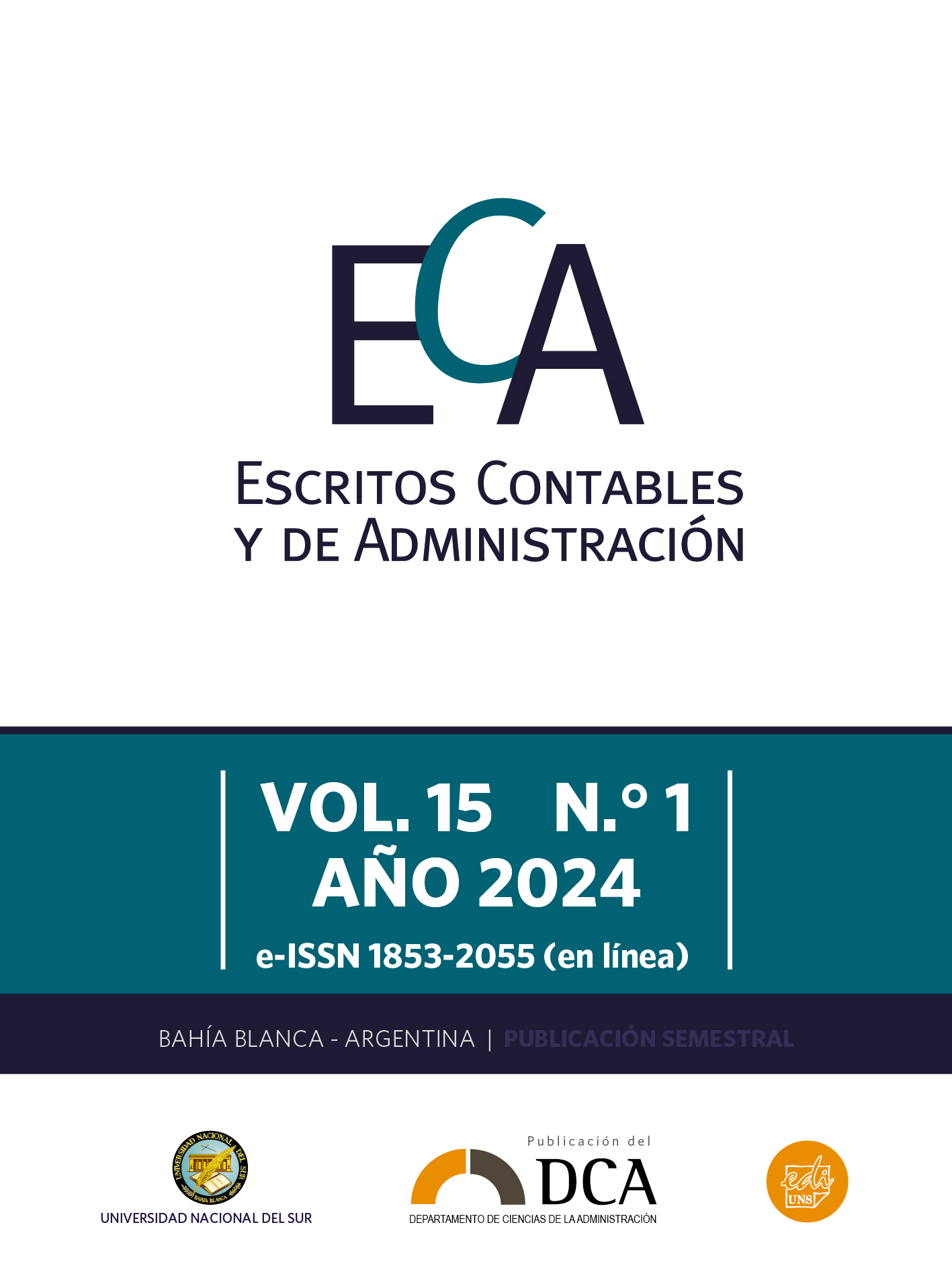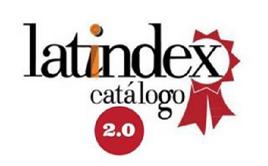Balanced Scorecard: an exploratory study on its userfulness in organizations
DOI:
https://doi.org/10.52292/j.eca.2024.4272Keywords:
balanced scorecard, management accounting, SMEs, intangible assetsAbstract
Is the balanced scorecard still one of the current tools used by professional practice in management accounting? More than thirty years have passed since 1992 when Kaplan and Norton published in the Harvard Business Review the article that gave rise to the development of the Balanced Scorecard (BSC) as a Management Accounting tool. The objective of this paper is to describe the validity of the BSC as a management accounting tool in organizations in general and in small companies in particular, and its contribution to the decision-making process. An exploratory and descriptive study is proposed through a literature review and a survey to accounting students and professionals. As a result of the survey, its subsequent analysis and classification based on research findings, it can be confirmed that the BSC continues to be a useful tool for management accounting, posing challenges for its development and adaptation to different organizations.
Downloads
References
Las referencias marcadas con un asterisco indican estudios incluidos en el meta-análisis.
*Agostino, D. y Arnaboldi, M. (2012). Design issues in Balanced Scorecards: The “what” and “how” of control. European Management Journal, 30(4), 327-339. https://doi.org/10.1016/j.emj.2012.02.001
Antonelli, N. M. y Solari, E. (Coordinadoras). (2023). Contabilidad para la gestión estratégica, Generando un Sistema de Información (SIIC) para la toma de decisiones. EDULP. http://dx.doi.org/10.35537/10915/162907
Atkinson, A. A., Balakrishnan, R., Booth, P. y Cote, J. M. (1997). New directions in management accounting research. Journal of Management Accounting Research, 9(1), 79-108. https://www.proquest.com/docview/210169631?pq-origsite=gscholar&fromopenview=true&-sourcetype=Scholarly%20Journals
Ballvé, A. M. (2006). Creando conocimiento en las organizaciones con el Cuadro de Mando Integral y el Tablero de Control. Revista de Contabilidad y Dirección, (3), 13-38. http://dx.doi.org/10.35376/10324/4155
Ballvé, A. M. y Amat-Salas, O. (2006). Los cuadros de mando como sistemas interactivos. Revista Iberoamericana de Contabilidad de Gestión, 4(8), 59-82. https://dialnet.unirioja.es/servlet/articulo?codigo=2158979
Banchieri, L. C. y Planas, F. C. (2012). El cuadro de mando integral: Teoría o realidad. Revista Iberoamericana de Contabilidad de Gestión, 10(20), 1-18. https://dialnet.unirioja.es/servlet/articulo?codigo=6652921
*Banker, R. D., Chang, H. y Pizzini, M. (2011). The judgmental effects of strategy maps in balanced scorecard performance evaluations. International Journal of Accounting Information Systems, 12(4), 259-279. http://dx.doi.org/10.1016/j.accinf.2011.08.001
Bastidas-B., E. L. y Ripoll-Feliu, V. (2003). Una aproximación a las implicaciones del cuadro de mando integral en las organizaciones del sector público. Compendium: Revista de Investigación Científica, (11), 23-41. http://dx.doi.org/10.2307/j.ctvckq9hf.5
*Bazett, M., Bowden, I., Love, J., Street, R. y Wilson, H. (2005). Measuring multichannel effectiveness using the balanced scorecard. Interactive Marketing, 6(3), 224-231. http://dx.doi.org/10.1057/palgrave.im.4340289
Biondi, M. (2007). La contabilidad, un sistema de información. Errepar.
*Biondi, M. (2012). Información contable proyectada o prospectiva. Contabilidad y Auditoría, (25), 11-57. https://ojs.econ.uba.ar/index.php/Contyaudit/article/view/105
Bisbe, J. (2010). La mayoría de edad del cuadro de mando integral. Harvard Deusto Business Review, (189), 48-62. https://www.harvard-deusto.com/la-mayoria-de-edad-del-cuadro-de-mando-integral
Bolisani, E. y Bratianu, C. (2018). Emergent knowledge strategies: strategic thinking in knowledge management. Springer International Publishing. http://dx.doi.org/10.1007/978-3-319-60657-6_8
*Bourguignon, A., Malleret, V. y Nørreklit, H. (2004). The American balanced scorecard versus the French tableau de bord: The ideological dimension. Management Accounting Research, 15(2), 107-134. http://dx.doi.org/10.1016/j.mar.2003.12.006
Bromwich, M. y Scapens, R. W. (2016). Management accounting research: 25 years on. Management Accounting Research, (31), 1-9. http://dx.doi.org/10.1016/j.mar.2016.03.002
Carrizo, W. O., Ferro, M. B. y Trola, C. R. (2014). Contabilidad: Teoría y Técnica. Haber.
Cebrián, M. y Cerviño, E. (2005). El balanced scorecard o Cuadro de Mando Integral y el Cuadro de Mando Tradicional: Principales diferencias. Técnica Contable, 57(673), 13-17. http://dx.doi.org/10.2139/ssrn.3625646
* Chytas, P., Glykas, M. y Valiris, G. (2011). A proactive balanced scorecard. International Journal of Information Management, 31(5), 460-468. http://dx.doi.org/10.2139/ssrn.3625646
*Da Silva Filho, J. B. B. y Rodríguez- González, R. R. (2004). Una nueva visión del cuadro de mando integral para el sector público. Revista Iberoamericana de Contabilidad de Gestión, 2(4), 117-148. http://dx.doi.org/10.7203/ciriec-e.99.14602
* Da Silva, G. R., Wanderley, V. P. C., Pereira, D. M. V. G. y Do Amaral Carneiro, L. M. M. (2020). Utilização de indicadores de desempenho à luz das perspectivas do balanced scorecard em cooperativas de créditos. Escritos Contables y de Administración, 11(1), 24-47. http://dx.doi.org/10.52292/j.eca.2020.1751
*Davis, S. y Albright, T. (2004). An investigation of the effect of balanced scorecard implementation on financial performance. Management Accounting Research, 15(2), 135-153. http://dx.doi.org/10.1016/j.mar.2003.11.001
*DeBusk, G. K., Brown, R. M. y Killough, L. N. (2003). Components and relative weights in utilization of dashboard measurement systems like the Balanced Scorecard. The British Accounting Review, 35(3), 215-231. http://dx.doi.org/10.1016/s0890-8389(03)00026-x
*Epstein, M. y Manzoni, J. F. (1998). Implementing Corporate Strategy: From Tableaux de Bord to Balanced Scorecards. European Management Journal, 16(2), 190-203. http://dx.doi.org/10.1016/s0263-2373(97)00087-x
*Finocchiaro, F. (10-11 de marzo, 2022). Más allá del Cuadro de Mando Integral clásico: La Necesidad de Nuevos Indicadores y Perspectivas [Ponencia]. 3° Foro Argentino de Contabilidad (FAC). Tandil, Argentina.
*Gibbons, R. y Kaplan, R. S. (2015). Formal Measures in Informal Management: Can a Balanced Scorecard Change a Culture? The American Economic Review, 105(5), 447-451. http://dx.doi.org/10.1257/aer.p20151073
Ghiglione, F. A. (2021). El Cuadro de Mando Integral como herramienta de eficiencia en la gestión empresarial. Ciencias Administrativas, (18), 87-93. http://dx.doi.org/10.24215/23143738e088
*Griffith, R. y Neely, A. (2009). Performance Pay and Managerial Experience in Multitask Teams: Evidence from within a Firm. Journal of Labor Economics, 27(1), 49–82. https://doi.org/10.1086/596324
*Hansen, E. G. y Schaltegger, S. (2016). The sustainability balanced scorecard: A systematic review of architectures. Journal of Business Ethics, 133(2), 193-221. http://dx.doi.org/10.1007/s10551-014-2340-3
*Hasan, R. U. y Chyi, T. M. (2017). Practical application of Balanced Scorecard - A literature review. Journal of Strategy and Performance Management, 5(3), 87-103.
Hoque, Z. (2014). 20 years of studies on the balanced scorecard: trends, accomplishments, gaps, and opportunities for future research. The British Accounting Review, 46(1), 33-59. http://dx.doi.org/10.1016/j.bar.2013.10.003
Ittner, C. D., Larcker, D. F. y Meyer, M. W. (2003). Subjectivity and the weighting of performance measures: Evidence from a balanced scorecard. The Accounting Review, 78(3), 725-758. http://dx.doi.org/10.2308/accr.2003.78.3.725
Jazayeri, M. y Scapens, R. W. (2008). The Business Values Scorecard within BAE Systems: The evolution of a performance measurement system. The British Accounting Review, 40(1), 48-70. http://dx.doi.org/10.1016/j.bar.2007.10.007
Kaplan, R. S. y Johnson H. T. (1988). La Contabilidad de Costes: Auge y caída de la contabilidad de gestión (Trad. M. Durán). Plaza & Janes Editores S.A. (Trabajo original publicado en 1987).
Kaplan, R. S. y Norton D. P. (1992). The Balanced Scorecard: Measures that Drive Performance. Harvard Business Review, 70(1), 71-79. https://www.hbs.edu/faculty/Pages/item.aspx?num=9161
*Kaplan, R. S. y Norton, D. P. (1993). Putting the Balanced Scorecard to Work. Harvard Business Review, 71(5), 1-16. https://hbr.org/1993/09/putting-the-balanced-scorecard-to-work
* Kaplan, R. S. y Norton, D. P. (1996). The Balanced Scorecard: Translating Strategy into Action. Harvard Business Review Press.
Kaplan, R. S. y Norton, D. P. (1996). Using the balanced scorecard as a strategic management system. Harvard Business Review, 74(1), 1-15. https://hbr.org/2007/07/using-the-balanced-scorecard-as-a-strategic-managementsystem
*Kaplan, R. S. y Norton, D. P. (2001). The Strategy-Focused Organization: How Balanced Scorecard Companies Thrive in the New Business Environment. Harvard Business Review Press. http://dx.doi.org/10.1007/bf03396637
*Kaplan, R. S. y Norton, D. P. (2004). Mapas Estratégicos. Convirtiendo Activos Intangibles en Resultados Tangibles. Gestión 2000.
*Kaplan, R. S. y Norton, D. P. (2006). Alignment: Using the Balanced Scorecard to Create Corporate Synergies. Harvard Business Review Press. https://www.hbs.edu/faculty/Pages/item.aspx?num=21112
Kaplan, R. S. y Norton, D. P. (2007). Using the Balanced Scorecard as a Strategic Management System. Harvard Business Review, (1), 75-85. https://hbr.org/2007/07/using-the-balanced-scorecard-as-a-strategic-managementsystem
Kaplan, R. S. y Norton, D. P. (2012). The execution premium: Integrando la estrategia y las operaciones para lograr ventajas competitivas. Temas Grupo Editorial.
Kaplan, R. S. y Norton, D. P. (2018). El Cuadro de Mando Integral: The Balanced Scorecard (3a ed. rev.). Harvard Business Press.
*Kasurinen, T. (2002). Exploring management accounting change: The case of balanced scorecard implementation. Management Accounting Research, 13(3), 323-343. http://dx.doi.org/10.1006/mare.2002.0191
*Kraus, K. y Lind, J. (2010). The impact of the corporate balanced scorecard on corporate control: A research note. Management Accounting Research, 21(4), 265-277. http://dx.doi.org/10.1016/j.mar.2010.08.001
*Länsiluoto, A. y Järvenpää, M. (2010). Greening the balanced scorecard. Business Horizons, 53(4), 385-395. http://dx.doi.org/10.1016/j.bushor.2010.03.003
Lev, B. y Gu, F. (2017). El final de la contabilidad: La contabilidad actual está muriendo. Cómo informar de lo que realmente importa a accionistas y directivos. Profit Editorial.
*Malagueño, R., Lopez-Valeiras, E. y Gomez-Conde, J. (2018). Balanced scorecard in SMEs: Effects on innovation and financial performance. Small Business Economics, 51(1), 221-244. http://dx.doi.org/10.1007/s11187-017-9921-3
*Malmi, T. (2001). Balanced scorecards in Finnish companies: A research note. Management Accounting Research, 12(2), 207-220. http://dx.doi.org/10.1006/mare.2000.0154
Mattessich, R. (1995). Conditional-normative accounting methodology: Incorporating value judgments and means-end relations of an applied science. Accounting, Organizations and Society, 20(4), 259-284. http://dx.doi.org/10.1016/0361-3682(94)00023-o
*Meadows, M. y Pike, M. (2010). Performance management for social enterprises. Systemic Practice and Action Research, 23(2), 127-141. http://dx.doi.org/10.1007/s11213-009-9149-5
*Mooraj, S., Oyon, D. y Hostettler, D. (1999). The balanced scorecard: a necessary good or an unnecessary evil European Management Journal, 17(5), 481-491. http://dx.doi.org/10.1016/s0263-2373(99)00034-1
*Norreklit, H. (2000). The balance on the balanced scorecard a critical analysis of some of its assumptions. Management Accounting Research, 11(1), 65-88. http://dx.doi.org/10.1006/mare.1999.0121
*Olson, E. M. y Slater, S. F. (2002). The balanced scorecard, competitive strategy, and performance. Business Horizons, 45(3), 11-16. http://dx.doi.org/10.1016/s0007-6813(02)00198-2
*Papalexandris, A., Ioannou, G., Prastacos, G. y Soderquist, K. E. (2005). An integrated methodology for putting the balanced scorecard into action. European Management Journal, 23(2), 214-227. http://dx.doi.org/10.1016/j.emj.2005.02.004
Pasero, S., Antonelli, N., Crego, L., Sorbelli, C., Solari, E., González, P. y Pedrini, J. (2023). Herramientas para el análisis y evaluación estratégica. En N. Antonelli y E. Solari (Coordinadoras.), Contabilidad para la gestión estratégica. Generando un Sistema de Información (SIIC) para la toma de decisiones (pp. 81-116). EDULP. http://dx.doi.org/10.35537/10915/162907
Porporato, M. (2007). Revisión de la Evolución de la Literatura Anglosajona en Contabilidad de Gestión. Revista Costos y Gestión, 17(66), 63-86. http://dx.doi.org/10.15446/innovar.v31n82.98427
Porporato, M. y García, N. (2007). Análisis de las limitaciones del Cuadro de Mando Integral: Revisión de la literatura e implicaciones para la práctica. Revista Iberoamericana de Contabilidad de Gestión, 5(9), 13-32. http://dx.doi.org/10.35376/10324/4155
*Porporato, M. y García, N. (2011). Sistemas de control de gestión: Un estudio exploratorio de su efecto sobre el desempeño organizacional. Academia. Revista Latinoamericana de Administración, (47), 61-77. http://dx.doi.org/10.33937/reveco.2011.23
Quesado, P. R., Rodrigues, L. L. y Guzmán, B. A. (2016). Aspectos críticos del Cuadro de Mando Integral: Un análisis bibliográfico. Revista Eletrônica de Estratégia & Negócios, 9(3), 1-29. https://doi.org/10.19177/reen.v9e32016248--280
Quesado, P. R., Rodrigues, L. L. y Guzmán, B. A. (2017). La incertidumbre percibida del entorno y el apoyo de la alta dirección en la implementación del Cuadro de Mando Integral. RC&C. Revista de Contabilidade e Controladoria, 9(2), 11-22. http://dx.doi.org/10.5380/rcc.v9i2.50275
Rigby, D. y Bilodeau, B. (2015). Management tools & trends 2015. Bain & Company, https://media.bain.com/Images/BAIN_BRIEF_Management_Tools_2015.pdf
*Royer, D. y Meints, M. (2009). Enterprise identity management–towards a decision support framework based on the balanced scorecard approach. Business & Information Systems Engineering, 1(3), 245-253. http://dx.doi.org/10.1007/s12599-009-0052-5
Rubín, C. N. (2017). Mapas Z: Aplicación de los números Z en los mapas estratégicos [Tesis de Doctorado, Universidad de Buenos Aires]. http://bibliotecadigital.econ.uba.ar/download/tesis/1501-1272_RubinCN.pdf
Scapens, R. W. (1994). Never mind the gap: Towards an institutional perspective on management accounting practice. Management Accounting Research, 5(3-4), 301-321. http://dx.doi.org/10.1006/mare.1994.1019
*Scoponi, L. (2016). Balanced scorecard para el desarrollo sustentable en empresas agropecuarias. Management Control Review 1(1), 2-23. http://repositoriodigital.uns.edu.ar/handle/123456789/4170
Scott, M. C. (1999). El proceso de creación de valor en la empresa (Value Drivers). Deusto.
*Speckbacher, G., Bischof, J. y Pfeiffer, T. (2003). A descriptive analysis on the implementation of balanced scorecards in German-speaking countries. Management Accounting Research, 14(4), 361-388. http://dx.doi.org/10.1016/j.mar.2003.10.001
*Tawse, A. y Tabesh, P. (2022). Thirty years with the balanced scorecard: What we have learned. Business Horizons. http://dx.doi.org/10.1016/j.bushor.2022.03.005
*Tirole, J. (2001). Corporate Governance. Econometrica, 69(1), 1–35. https://doi.org/10.1111/1468-0262.00177
*Varghese, J. (2007). Applying Three Frames to the Delivery of Public Value. En J. Wanna (Ed.), Improving Implementation: Organisational Change and Project Management (pp. 107–12). ANU Press.http://dx.doi.org/10.22459/ii.02.2007.09
Voelpel, S. C., Leibold, M. y Eckhoff, R. A. (2006). The tyranny of the Balanced Scorecard in the innovation economy. Journal of Intellectual Capital, 7(1), 43-60. http://dx.doi.org/10.1108/14691930610639769
*Wiersma, E. (2009). For which purposes do managers use Balanced Scorecards? An empirical study. Management Accounting Research, 20(4), 239-251. http://dx.doi.org/10.1016/j.mar.2009.06.001
*Zeng, K. y Luo, X. (2013). The balanced scorecard in China: Does it work? Business Horizons, 56(5), 611-620. http://dx.doi.org/10.1016/j.bushor.2013.06.001
Published
How to Cite
Issue
Section
License
Copyright (c) 2024 Julián Horacio Pedrini

This work is licensed under a Creative Commons Attribution-NonCommercial 4.0 International License.
Aviso de derechos de autor
Aquellos autores/as que tengan publicaciones con esta revista, aceptan los términos siguientes:
- Los autores/as conservarán sus derechos de autor y garantizarán a la revista el derecho de primera publicación de su obra, el cual estará simultáneamente sujeto a la licencia Atribución-No Comercial 4.0 Internacional CC BY-NC 4.0.
- Los autores/as podrán adoptar otros acuerdos de licencia no exclusiva de distribución de la versión de la obra publicada (p. ej.: depositarla en un archivo telemático institucional o publicarla en un volumen monográfico) siempre que se indique la publicación inicial en esta revista.
- Se permite y recomienda a los autores/as difundir su obra a través de Internet (por ej.: en páginas web institucionales o personales) una vez publicado su trabajo, lo cual puede producir intercambios interesantes y aumentar las citas de la obra publicada (Véase El efecto del acceso abierto).





















